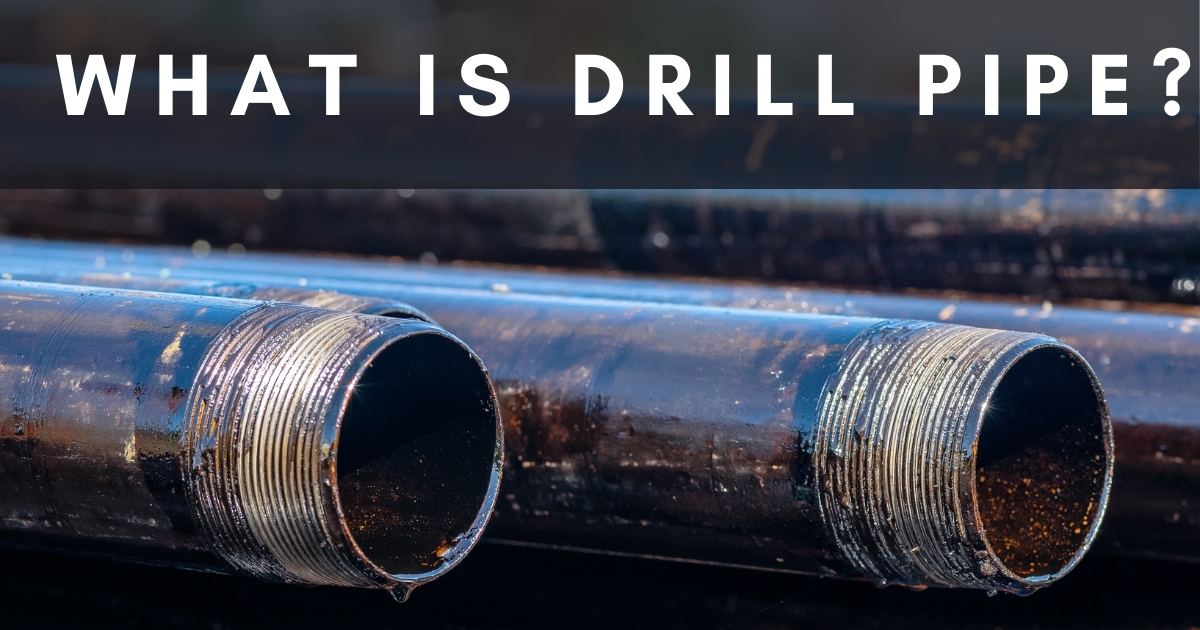A drill pipe is a tubular steel pipe that plays a crucial role in the process of drilling for oil and gas. An oilfield pipe is an integral part of the drilling string, connecting the surface drilling equipment to the drill bit and allowing for the circulation of drilling fluids.
But there’s a lot more to know than just what is drill pipe, what it does, and how to maintain it. This article will aim to explain everything you need to to know about drill pipes. Read on!
How Does a Drill Pipe Work?
Drill pipe serves as a conduit or tubing for the drilling fluid, or the drilling mud. This fluid is essential for cooling and lubricating the drill bit, carrying cuttings to the surface, and maintaining pressure in the well bore.
The upper end of the drill pipe is connected to the drilling rig’s rotary table or top drive system. This connection is the main component that allows for the transfer of rotational power from the rig to the oil drill pipe.
Types of Drill Pipes
There are various kinds of drill pipes, including:
Standard Drill Pipe
Standard drill pipes are available in a range of diameters and wall thicknesses, allowing for flexibility in different drilling scenarios.
The lengths typically range from 30 to 32 feet, but variations exist based on industry standards and specific drilling requirements.
Common thread types for standard drill pipes include API connections, with a couple of configurations such as API Regular and API IF.
API Regular and API IF are two types of threaded connections commonly used in the oil and gas industry for drill pipes and other drilling equipment.
These connections are standardized by the American Petroleum Institute (API) to ensure compatibility and reliability in drilling operations.
Heavy-Weight Drill Pipe
Heavy-weight drill pipes serve the purpose of adding weight to the drill string, which can be beneficial for achieving better weight on the bit and improving the rate of penetration.
In addition to weight, a weighted drill pipe contributes to stabilizing the bottom hole assembly, reducing vibration, and ensuring more efficient drilling. This is why most companies prefer using a heavy weight drill pipe instead of a regular drill pipe connection.
What is a Drill Collar?
Drill collars, which are integral components of the drill string, play a pivotal role in optimizing drilling operations.
Positioned over the drill bit or near the bottom of the drill string, these heavy, thick-walled tubular components serve crucial functions that significantly impact drilling efficiency. With these, the oil drilling can be done seamlessly.
Concentration of Weight
Drill collars are strategically placed to concentrate additional weight on the drill bit. This deliberate weight distribution enhances the effectiveness of the drilling process by improving the rate of penetration and allowing better control over the drilling trajectory.
Enhancing Drilling Effectiveness
Because of their weight concentration, drill collars contribute to the transmission of force to the drill bit, allowing it to penetrate the subsurface a lot more efficiently.
This is particularly beneficial in challenging geological conditions where increased weight on the bit is essential for progress.
Borehole Stability
One of the primary functions of drill collars is to enhance borehole stability.
They play a key role in minimizing wellbore deviation and keeping the drill string from going off course.
This stability is crucial for maintaining accuracy in drilling, especially when targeting specific subsurface zones.
Preventing Hole Enlargement
Drill collars also act as stabilizers by reducing the risk of hole enlargement.
Their thick-walled design helps in mitigating the natural tendency of the borehole to enlarge due to geological and drilling-related factors.
Synergy with the Drilling Pipe
The drilling pipe, though essential, relies on the presence of drill collars to maximize its effectiveness.
The combination of the two components creates a balanced and well-coordinated drilling system, ensuring optimal performance in various drilling scenarios.
Critical Component in the Drill String
Drill collars aren’t just optional additions; they are an indispensable part of the drill string.
Their presence is fundamental for overcoming challenges posed by different geological formations and drilling conditions.
Components and Construction
The outer diameter of the drill pipe varies based on the specific requirements of the drilling operation. Common sizes range from 2 to 6 inches.
The wall thickness is an important consideration for the structural integrity of the drill pipe. It is based on factors such as the anticipated loads and drilling conditions.
The upper end of the drill pipe is equipped with a tool joint that facilitates the connection to the drilling rig’s rotary table or top drive system.
This connection point is critical for transferring rotational power from the rigs to the drill pipes.
The lower end of the drill pipe also has a tool joint, allowing for connection to other drill pipes or bottom hole assembly components, such as a heavyweight drill pipe or drill collars.
Upset and Non-Upset Ends
Upset and non-upset ends refer to the design of the ends of a drill pipe, specifically the tool joints.
These terms describe whether the ends of the pipe have additional material (upset) or have a consistent diameter (non-upset).
Upset Ends
Upset ends refer to the thicker-walled portion at the ends of the drill pipe.
This design increases the overall strength of the pipe, providing better resistance to wear and tear. Upset ends are often used in critical sections of the drill string, especially near the tool joints.
Non-Upset Ends
Non-upset ends have a consistent wall thickness throughout the length of the drill pipe.
While they may not offer the same level of strength as upset ends, they are often more cost-effective and suitable for sections of the drill string where additional strength is not as critical.
Properties and Specifications
Drill pipes are designed to bear significant loads and stresses during drilling operations. The material, often a high-strength alloy or carbon steel, is chosen for its ability to provide the required tensile strength to support the weight of the drill string and transmit torque to the drill bit.
The strength of the drill pipe is crucial for preventing failures, such as fractures, that could occur under the high pressures and forces encountered in the wellbore.
Toughness is essential for the ability of the drill pipe to absorb and withstand impact and cyclic loading without undergoing failure. Tough materials can resist cracking and ensure the drill pipe’s reliability in challenging drilling conditions.
Heat treatment processes, such as quenching and tempering, are often employed to optimize the balance between strength and toughness in the drill pipe material.
Materials Used in Drill Pipe
Drill pipes are made of carbon or alloy steel. Commonly used in drill pipe manufacturing, carbon steel provides strength and durability. High-strength alloy steel is often employed for enhanced mechanical properties.
Steel, with its inherent strength and robust nature, is a primary material in drill pipe construction, ensuring the ability to withstand demanding drilling conditions and contributing to the extended lifespan of drill pipes.
Stainless steel has specific applications in the drilling industry, primarily due to its corrosion resistance. This is especially relevant in environments with corrosive drilling fluids or harsh downhole conditions.
The unique properties of stainless steel make it suitable for specific components within the drill string, enhancing its overall performance and longevity.
Stainless steel components play a crucial role in mitigating challenges posed by corrosive drilling fluids and harsh downhole conditions, ensuring the integrity of the drill string over time.
Conclusion
The intricacies of drill pipe construction and its associated components are vital elements in the success of oil and gas drilling operations.
From the foundational strength of the pipe body to the specialized functions of components like drill collars, each part plays a crucial role in optimizing drilling efficiency and ensuring the integrity of the wellbore.
With everything working seamlessly, the manufacturing process becomes easy, and the drilling rig can function at full capability.

